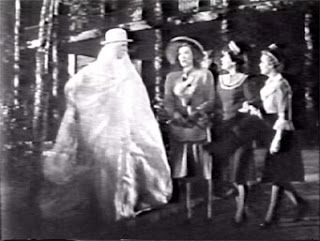The haunted
house became a trusty setting for a mixture of horror and comedy for Forties war-time
audiences. It offered a ready-made opportunity for disparate groups of people
to be brought together and challenged by a spooky mansion’s mythology - in
particular those who could gain mileage from an amusingly cowardly persona such
as Bob Hope (The Cat and the Canary, The Ghost Breakers) or Abbott and
Costello (Hold That Ghost). There was
also an excuse to shoehorn in musical performances by way of entertaining the
guests and calming each other’s fears. In December 1944 Universal released the
B-movie Murder in the Blue Room which
contained both in a genial, fast-moving piece of candy-floss.
Script-wise,
it’s of passing Hollywood history interest as the first screenplay co-credited
to I.A.L. Diamond, Billy Wilder’s famous partner in crafting such comedy
classics as Some Like it Hot (1959) and
The Apartment (1960). The other notable
facet was the fresh coat of paint applied by making the laughter providers a female-centric
team. Originally Blue Room was
intended as a vehicle for the Ritz Brothers, Fox’s former resident trio of
knockabout gagmeisters (rivalling Columbia’s Three Stooges) who left for
Universal after complaining about the shoddiness of The Gorilla (reviewed here). The studio plugged them into a series
of musical comedies until they disbanded as a threesome in 1943.
Blue Room was then remodelled to showcase
three spirited and talented song-and-dance actresses to form the plot’s nightclub
act The Three Jazzybelles, a close-harmony trio clearly inspired by the
successful Andrews Sisters who had already co-starred with the Ritz Brothers
and Abbott and Costello. The team of Grace McDonald, Betty Kean and June
Preisser blend together so convincingly that it’s a surprise to find they were entirely
separate performers in real life. Cute diminutive blond Preisser made her name
as a love rival to Judy Garland for Mickey Rooney in Babes in Arms (1939) and Strike
up the Band (1940). McDonald, the gals’ sensible brunette leader, started
out as a brother-sister tap team before landing a series of B-picture musicals
with Paramount that slotted her into films designed for the Andrews sisters. Tall,
kooky redhead Betty Kean began as one half of a duo with her sister Jane; her
madcap rangy physicality recalls the ‘loose-limbed lunacy’ ascribed to the
young Jonathan Miller.
The basic
plot is a straightforward piece of frippery concerning a high-society family whose
palatial home conceals a macabre Blue Room in which the patriarch died under
mysterious circumstances twenty years ago. Since then no-one has been allowed
in, until two men vying for the hand of the eligible Nan (Weird Woman and House of
Frankenstein‘s beautiful Anne Gwynne) compete to impress her with their
bravery by each volunteering to spend a night there – with fatal consequences.
The Jazzybelles ladies are brought in as old fellow performer friends of Nan’s to
perform for the gathering and soon become embroiled on suspicion of murder.
As opposing suitors
Larry and mystery writer Steve the duelling pair of Bill Williams and Donald
Cook are fairly interchangeable stock players, whose disappearance/murders are
less engaging than the byplay between the Jazzybelles. After Nan gets an opening
solo, the girls then eclipse everyone with their sassy blue-collar “Gee, that’s
swell” attitudes and three musical numbers that showcase their excellent vocal
and tap chops. They also get the lion’s share of the comedy with the kind of rim-shot
vaudeville shtick that rattles along agreeably enough:
“I came for
the bags”
“He’s not
only gruesome – he’s insulting”.
That
sequence is part of a brief Chauffeur cameo by Milton Parsons, the busy,
bald-headed eccentric specialist we glimsped earlier as the Funeral Director in
Cry of the Werewolf.
As guests
unknown to most of the party, the Jazzybelles are chief suspects targeted by Regis
Toomey’s Inspector McDonald, one of those fedora-wearing cops hard-boiled
enough to resemble Warner Brothers’ gangsters (another of which he’d play in that
studio’s classic The Big Sleep a year
later). They also fall foul of butler Edwards played by the enormously prolific
Ian Wolfe whose credits spanned from the Thirties right up to 1990’s Dick Tracy, working until his death at
age 95). He gets in a memorably game burst of showbiz sparring with the gals:
“My mother
warned me against people like you. She said acting is the devil’s profession”
“Are you saying actors are bad?”
“Are you saying actors are bad?”
“In yours
case, decidedly yes”.
The
negligible chills in the film are really just for fun, courtesy of a
self-playing piano during McDonald and Preisser’s bravura tap set-piece, a clichéd
pantomime-style hand taunting the girls in bed and an inexplicable but funny turn
by Robert Cherry as an actual ghost complete with transparent bed-sheet body
topped with a white derby. His two appearances make no sense but are thrown in
as part of the breezy devil-may-care tone.
The brisk
60-minute running time ensures that such daffy developments and any lame gags
are never dwelt on, meaning that Murder
in the Blue Room doesn’t outstay its welcome on a rainy Sunday afternoon.



No comments:
Post a Comment